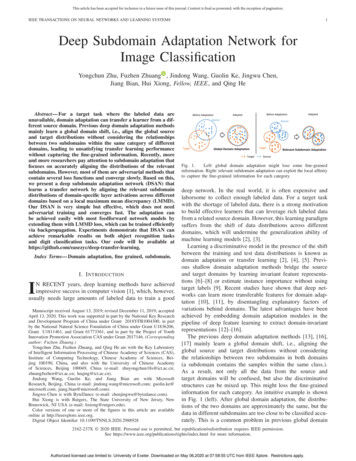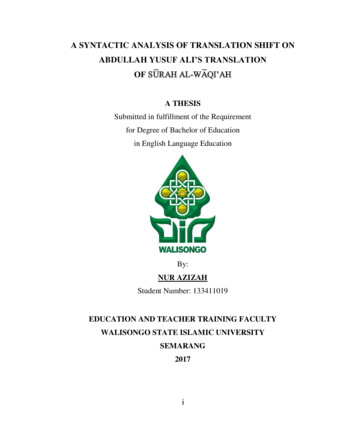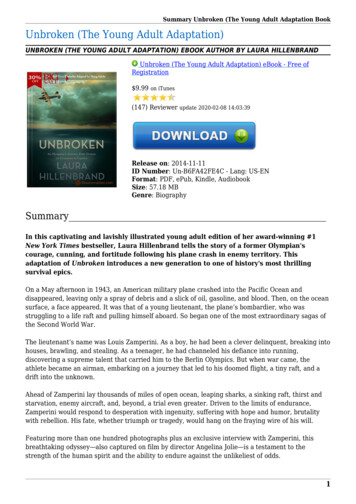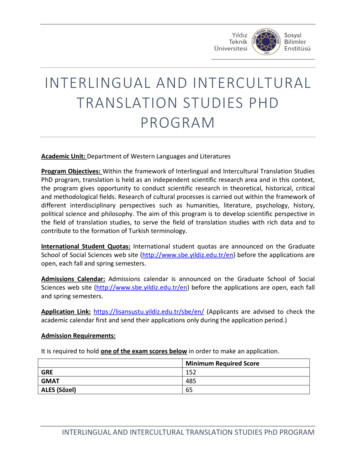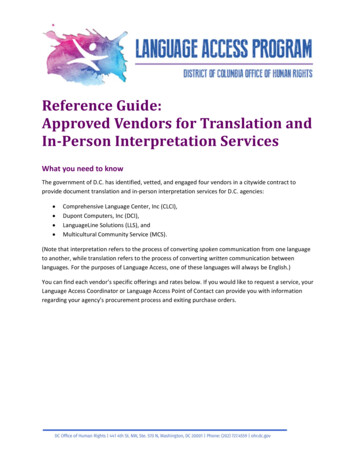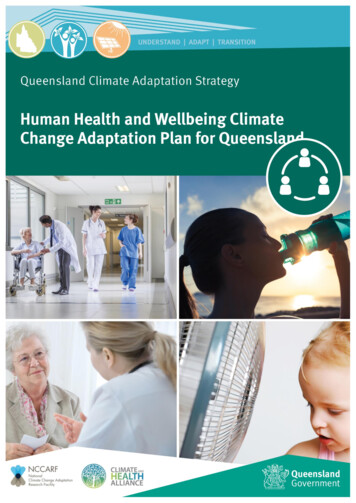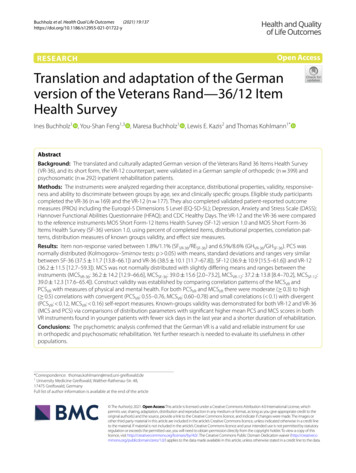
Transcription
(2021) 19:137Buchholz et al. Health Qual Life Open AccessRESEARCHTranslation and adaptation of the Germanversion of the Veterans Rand—36/12 ItemHealth SurveyInes Buchholz1 , You‑Shan Feng1,3 , Maresa Buchholz1 , Lewis E. Kazis2 and Thomas Kohlmann1*AbstractBackground: The translated and culturally adapted German version of the Veterans Rand 36 Items Health Survey(VR-36), and its short form, the VR-12 counterpart, were validated in a German sample of orthopedic (n 399) andpsychosomatic (n 292) inpatient rehabilitation patients.Methods: The instruments were analyzed regarding their acceptance, distributional properties, validity, responsive‑ness and ability to discriminate between groups by age, sex and clinically specific groups. Eligible study participantscompleted the VR-36 (n 169) and the VR-12 (n 177). They also completed validated patient-reported outcomemeasures (PROs) including the Euroqol-5 Dimensions 5 Level (EQ-5D-5L); Depression, Anxiety and Stress Scale (DASS);Hannover Functional Abilities Questionnaire (HFAQ); and CDC Healthy Days. The VR-12 and the VR-36 were comparedto the reference instruments MOS Short Form-12 Items Health Survey (SF-12) version 1.0 and MOS Short Form-36Items Health Survey (SF-36) version 1.0, using percent of completed items, distributional properties, correlation pat‑terns, distribution measures of known groups validity, and effect size measures.Results: Item non-response varied between 1.8%/1.1% (SFVR-36/RESF-36) and 6.5%/8.6% ( GHVR-36/GHSF-36). PCS wasnormally distributed (Kolmogorov–Smirnov tests: p 0.05) with means, standard deviations and ranges very similarbetween SF-36 (37.5 11.7 [13.8–66.1]) and VR-36 (38.5 10.1 [11.7–67.8]), SF-12 (36.9 10.9 [15.5–61.6]) and VR-12(36.2 11.5 [12.7–59.3]). MCS was not normally distributed with slightly differing means and ranges between theinstruments (MCSVR-36: 36.2 14.2 [12.9–66.6], MCSSF-36: 39.0 15.6 [2.0–73.2], M CSVR-12: 37.2 13.8 [8.4–70.2], M CSSF-12:39.0 12.3 [17.6–65.4]). Construct validity was established by comparing correlation patterns of the M CSVR and PCSVR with measures of physical and mental health. For both PCSVR and MCSVR there were moderate ( 0.3) to high( 0.5) correlations with convergent (PCSVR: 0.55–0.76, M CSVR: 0.60–0.78) and small correlations ( 0.1) with divergent (PCSVR: 0.12, MCSVR: 0.16) self-report measures. Known-groups validity was demonstrated for both VR-12 and VR-36(MCS and PCS) via comparisons of distribution parameters with significant higher mean PCS and MCS scores in bothVR instruments found in younger patients with fewer sick days in the last year and a shorter duration of rehabilitation.Conclusions: The psychometric analysis confirmed that the German VR is a valid and reliable instrument for usein orthopedic and psychosomatic rehabilitation. Yet further research is needed to evaluate its usefulness in otherpopulations.*Correspondence: thomas.kohlmann@med.uni-greifswald.de1University Medicine Greifswald, Walther‑Rathenau‑Str. 48,17475 Greifswald, GermanyFull list of author information is available at the end of the article The Author(s) 2021. Open Access This article is licensed under a Creative Commons Attribution 4.0 International License, whichpermits use, sharing, adaptation, distribution and reproduction in any medium or format, as long as you give appropriate credit to theoriginal author(s) and the source, provide a link to the Creative Commons licence, and indicate if changes were made. The images orother third party material in this article are included in the article’s Creative Commons licence, unless indicated otherwise in a credit lineto the material. If material is not included in the article’s Creative Commons licence and your intended use is not permitted by statutoryregulation or exceeds the permitted use, you will need to obtain permission directly from the copyright holder. To view a copy of thislicence, visit http:// creat iveco mmons. org/ licen ses/ by/4. 0/. The Creative Commons Public Domain Dedication waiver (http:// creat iveco mmons. org/ publi cdoma in/ zero/1. 0/) applies to the data made available in this article, unless otherwise stated in a credit line to the data.
Buchholz et al. Health Qual Life Outcomes(2021) 19:137Page 2 of 16Keywords: Quality of life, Veterans Rand 36 Items Health Survey, SF-36, SF-12, Health assessment, Health-relatedquality of lifeBackgroundHealth related quality of life (HRQoL) is a crucial outcome metric used in settings from clinical trials [1, 2] topopulation health surveillance [3–7]. The Veterans Randquestionnaire (VR) is a multi-attribute generic instrument measuring patient-reported HRQoL. The instrument has a long (VR-36) and a short form (VR-12), bothmeasuring a physical component summary (PCSVR) anda mental component summary ( MCSVR). The VR-36 alsois comprised of eight scales, which correspond closely tothe Medical Outcome Study (MOS) Short Form 36 version 1.0 (SF-36, [8–10]).The VR instruments were created to address the veteran population in the United States (US) [11]. The Veterans Health Administration (VHA) is a national healthcare system, which serves over nine million militaryveterans in the US. It is one of the largest integratedhealth care systems in the US. This patient populationhas special medical needs, is older, poorer, sicker (withmore diseases than veterans nationally) and has a higherpercentage of men than the general adult population[12–14]. The creation of the VR instruments has beenpreviously documented [13–16] and shown to be validfor the VA population [13, 17–27] as well as other general US populations [28–35]. The English-language VRinstruments have become an integral part of registries[36] and studies of National U.S. health programs [18, 37,38] including the evaluation of the Medicare AdvantageProgram by the Centers for Medicare and Medicaid Services (CMS). Advantages of the VR instruments includetheir validity in older and sicker populations, their availability (all instruments are in the public domain) andtheir strong psychometric properties across different andwide-ranging socio-demographic and clinical groups.In this study, we translated and culturally adapted theVR-36 into the German language (Germany) and validated the VR-36 and VR-12 in a population of Germanpatients undergoing inpatient rehabilitation. The German VR-36 and VR-12 were comprehensively validatedand compared to the SF-36 and SF-12 in inpatient populations of orthopedic and psychosomatic rehabilitationpatients (the two largest clinical indications of Germaninpatient rehabilitation patients).The SF-36 and the SF-12 are considered gold standardsof self-assessed generic health instruments and they havebeen extensively distributed and used across a wide rangeof countries, populations and purposes. They are recommended for measuring patient outcomes in the medicalrehabilitation setting in Germany [39–42]. Since the fieldof medical rehabilitation has been one of the most common applications of the SF-36 in the German-speakingcountries, it was important to compare the measurementproperties of the VR instruments to the SF-instrumentsin this setting.MethodsThe study was conducted in two phases: phase (A) translating and culturally adapting the original English VR-36into the German language (Germany); and phase (B) validating the VR-36 and its short version, the VR-12, in arandomized prospective study of inpatient rehabilitationpatients with orthopedic and psychosomatic conditions.Phase (A) translation and cultural adaptationof the German VRThe translation methodology followed a rigorous iterative forward–backward format to maintain the conceptual, functional, linguistic and cultural equivalencebetween the original (English) and the adapted (German)questionnaire. The translation procedure is summarizedin Fig. 1. First, a German translation of the VR-36 wasproduced from the English original version by an experienced translator (DB). Because the VR-36 is analogousto the SF-36, the official German translation of the SF-36items, which has already undergone rigorous translationand adaptation, served as a second translation to whichwe compared the forward translated VR items (German SF-36 Version 1 [8–10] and Version 2 [43]). A reconciled German VR-36 was produced after discussionof agreements and disagreements between the forwardtranslation, SF-36 Version 1 and SF-36 Version 2, andtranslated back into the source language (English) by anexperienced translator who is a native speaker of English and fluent in German. The backward translation wascompared to the original English VR-36. Any discrepancies between the back translation and the English VR-36were addressed with the back translator to determine theorigins of discrepancies in the first reconciled GermanVR-36. After this stage, a pre-final version was produced,which was tested in a cognitive debriefing process with26 patients and finalized afterwards.Phase (B) validation studyPatient recruitmentStudy participants were rehabilitation patients undergoing a three- or six-week inpatient rehabilitation due to an
Buchholz et al. Health Qual Life Outcomes(2021) 19:137Page 3 of 16Fig. 1 Flow chart of the translation processFig. 2 Survey study designorthopedic or a psychosomatic indication. Recruitmenttook place in five rehabilitation clinics between October 2015 and November 2017. Patients who did not hadcognitive or linguistic impairments were consecutivelyincluded in the study if they provided written informedconsent. Participants completed questionnaires at thebeginning (t1, baseline) and at the end (t2, three- to sixweek follow-up) of their course of rehabilitation. Basedon sample size calculations, which included drop-outassumptions of 20%, a study sample of n 800 patientsat t1 (n 400/clinical indication and n 200/instrumentversion) and n 640 patients at t2 (n 320/clinical indication and n 160/instrument version) was targeted.Because the SF-36, the VR-36, the SF-12 and the VR-12questionnaires are very similar, participants were randomly assigned to one of four groups (block-randomization) to complete only one of these instruments (Fig. 2).By block-randomization an indirect comparison betweenthe long- and the short-forms of the VR and the SF couldbe made.
Buchholz et al. Health Qual Life Outcomes(2021) 19:137The study was approved by the ethics committee of theUniversity Medicine Greifswald, Germany, and was conducted according to the Declaration of Helsinki.MeasuresIn addition to the VR and SF instruments, the patientquestionnaires contained several other self-report measures. These measures were chosen to correspond to theeight scales and the summary scores of the VR instruments in order to validate the VR instruments.The EQ-5D-5L questionnaire is an internationallywidely used preference-based measure of self-assessedhealth [44–46]. The questionnaire measures impairmentsin five dimensions of health using five items, each withfive levels of impairments, and a thermometer-like visualanalogue scale (EQ VAS). The values of the five items canbe converted into a preference-based single utility index.In the present study, index values were calculated usingthe German tariff [47].The Centers for Disease Control and Prevention (CDC)“Healthy Days” is a generic HRQoL questionnaire containing four items measuring self-rated health and thenumber of disability days (out of the last 30) due to physical and mental health or limitations in activities [48, 49].The instrument is valid and reliable [48].The Hannover Functional Abilities Questionnaire(HFAQ) is a 12-item generic measure of (physical) functional ability of daily activities [50–52]. Each item hasthree levels of functioning. All items can be combined toan additive summary score.The Depression, Anxiety and Stress Scale (DASS) is anextensively validated measure of mental health [53, 54].In this study, the short form (21-item, DASS-21) instrument was used.The Graded Chronic Pain Scale (GCPS) is an internationally established instrument developed by van Korffet al. [55, 56]. The GCPS measures self-rated pain intensity and pain disability using a 0 to 10 numeric ratingscale plus one item regarding number of disability days(in the past three months) due to pain using seven items.Summation of GCPS items produce scores describingpain intensity and pain disability.The Index for the Assessment of Health Impairments,IMET [57, 58], measures participation as defined by theWHO International Classification of Functioning, Disability and Health, ICF. The 9-item questionnaire wasapplied and tested in several samples from rehabilitationpatients of different clinical indications. It is suitable asa screening method to assess the risk of a failure in theprofessional reintegration of rehabilitation patients. Theinstrument is demonstrated to be an economic, highlypracticable, valid and reliable operationalization of “activities and participation” according to the concept of thePage 4 of 16ICF. Norm values for the IMET were assessed in a random sample of Lübeck inhabitants comprising subjectsbetween 19 and 79 years of age, and enable classification of limitations in participation for people undergoingrehabilitation or suffering from chronic diseases.The vitality subscale of the Indicators of the REhabilitation Status (IRES-VE) was included to examinethe construct validity of the VR items on vitality [59]. InGermany, the IRES is recommended (in addition to theSF-36) for rehabilitation research and practice [42].Statistical analysisThe VR-36 and the VR-12 were analyzed regarding thecompleteness of data on the scale-level, distributionalproperties, construct validity, known-groups validity,internal consistency (as one aspect of reliability), andresponsiveness to change. This was done on the summary scores of the VR-36 and the VR-12 (physical component score ( PCSVR) and mental component score (MCSVR)) as well as the eight VR-36 scales: (physicalfunctioning (PFVR-36), role functioning/physical (RPVR-36),role functioning/emotional ( REVR-36), vitality ( VTVR-36),mental health (MHVR-36), social functioning (SFVR-36),pain (BPVR-36), and general health ( GHVR-36)). The VRinstruments have not previously been used in Germanpopulations and normed scores have not yet been developed. Therefore, summary scores and scales were scoredaccording to the VR-36 and VR-12 algorithms, using at-score transformation with a mean of 50 and a standarddeviation of 10 and normed to a general sample of the USpopulation for the summary scales (PCS and MCS) [23,60–62]. The scoring algorithms for the VR-36 and theVR-12 impute for missing data. VR-12 extrapolates scoring based on the missing pattern; VR-36 conducts meanimputation at the subscale level if less than 50% of thesubscale items is missing. In all analyses, all available datawere used (available case analysis). Because the SF-36and the SF-12 instruments are well validated across arange of populations, they were used as the comparatorto the VR instruments for all analyses.Completeness of data is an indicator of data qualityand acceptance of the questionnaire by respondents. Thepercentage of non-missing responses was calculated forthe eight VR-36 scales, stratified by respondent characteristics (e.g. clinical indication, age, sex, education). Noimputation was carried out to deal with missing data forstatistical analyses.Distributional properties (such as means, standarddeviations and range) for the VR instruments were analyzed on the scale and summary score levels. To comparethe distributional properties of the PCS and MCS forboth the VR-12 and SF-12 as well as the VR-36 and theSF-36, classical statistical indices of distribution such as
Buchholz et al. Health Qual Life Outcomes(2021) 19:137mean, standard deviation, minimum, maximum, skewness (to assess and compare the type and strength ofsymmetry) and kurtosis (as a measure of the steepness/ flatness of the frequency distribution) were assessed.Kolmogorow-Smirnov-test was used to compare the distributions of the two summary scores of the VR and theSF—i.e. PCSVR and PCSSF as well as MCSVR and MCSSF.Kernel density plots using the Epanechnikov functionwere used to visually examine distribution of summaryscores and scales.Construct validity refers to the degree of accuracy withwhich a measurement instrument captures the constructit claims to measure. To examine construct validity, Pearson correlation coefficients (rp) between VR summaryscores (PCSVR and MCSVR) and other self-completedhealth measures were assessed. We compared these tothe correlations between the PCSSF and MCSSF withother self-completed health measures. Correlation coefficients were compared using significance tests for correlations for independent samples [63]. The correlationsbetween PCSVR and other self-reported physical healthmeasures (e.g. HFAQ, CDC Physical unhealthy days,GCPS Disability) were expected to be higher (convergent validity) than with self-report measures of mentalhealth (divergent validity). Similarly, MCSVR is expectedto be more strongly correlated with self-reported mental health measures (e.g. DASS-Anxiety, DASS-Stress,DASS-Depression, CDC Mental unhealthy days) thanwith physical measures. Both PCS and MCS are expectedto be similarly correlated with generic self-report measures (e.g. EQ VAS, IMET) and GCPS-Pain. Correlationswere interpreted as follows: rp 0.1 small, 0.3 rp 0.5moderate, rp 0.5 high/strong [64].Known-groups validity is a criteria-based techniqueto investigate the ability of a measure to discriminatebetween groups known to differ in the construct of interest. For this study, known-groups were defined by clinical indication (psychosomatic, orthopedic), treatmentprogram (“curative therapy” typically for chronically illpatients, “medical follow-up treatment” generally afterjoint replacement, only for orthopedic patients) age( 45 years, 45–65 years, 65 years), duration of rehabilitation (median), sick days in the past 12 month, self-ratedhealth (SRH, “excellent/very good/good” vs. “fair/poor”).We examined if mean PCSVR and mean MCSVR scoreswere significantly different between those pre-definedgroups using t-tests for two groups or ANOVA for morethan two groups.Internal consistency (IC) is a measure of reliability. Ascale is considered reliable if its items are homogeneous—i.e., highly correlated because they measure thesame underlying construct [65]. In this study, Cronbach’s alpha was used as a measure of IC with α 0.7Page 5 of 16interpreted as acceptable, α 0.8 as good, and α 0.9 asexcellent.Responsiveness refers to a self-assessed health instrument’s ability to capture changes in health over time[66]. The raw difference of SF and VR summary scoresfrom t1 to t2 were divided by the pooled standard deviation of change to produce standardized response means(SRM), or divided by baseline standard deviation to produce standardized effect size (SES). As we assess patientsbefore and after an intensive treatment, analysis wererestricted to respondents who reported stable (t1 t2) orimproved (t1 t2) health on a single SRH item (n 133)to assess responsiveness to health improvements. Wefurther checked improvement (from t1 to t2) for all PCSand MCS-scores of all four instruments using pairedt-tests. The magnitude of changes in scores (expressedas SRM and SES) was interpreted as following: valuesof 0.3 were considered as small, values between 0.3 and0.59 were considered as medium, and values 0.6 wereconsidered as large [67]. Since there are different methods to estimate the magnitude of change within groups,and consensus is lacking on their interpretation [68],we are calculating both SES and SRM for comparisonpurposes. Due to the repeated measurement design themeasurements are correlated, which was shown to affectthe magnitude of SRM [69]; to account for this, we additionally correlated both measurements (Pearson correlation coefficient, rt1/t2).Data were analyzed using IBM SPSS Statistics 24 andSTATA SE 13. Wherever applicable, analyses were stratified by clinical indication (orthopedic or psychosomaticrehabilitation).Results(A) Translation and cultural adaptation of the German VRThere were no major problems found in the forward–backward-translations. Reconciliation of the items didnot lead to problems. The field test yielded that mostof the questions (except for RE and RP instructions,response scales and questions) of the VR-36 are clear andsimple to both rehabilitation patients (n 15, 4 male, 11female, 30 to 80 years (mean 55.3 years)) and patientsfrom general practice (n 11, 25 to 77 years (mean57.4 years)) of all ages. Additional file 1 shows the keyissues that were discussed during the translation process (forward–backward translation, reconciliation andcognitive debriefing) and how the items were reconciled.Besides the already described adaptation needs identified during the cognitive debriefings, adaptations to thecultural context were needed. The German SF-36 wasused as a guide in these decisions. For example, playinggolf (used as example in one item) is a less popular activity in Germany than for the USA. In the considerations
Buchholz et al. Health Qual Life Outcomes(2021) 19:137Page 6 of 16Table 1 Sample characterization at baseline Age, M SD (range)52.0 11.3(23–89)53.2 11.3(22–84)54.1 8.9(23–78)52.0 10.7(20–77)52.8 10.6(20–89)Sex, % Married/living with partner65.167.565.663.765.5High school28.825.224.328.726.8Secondary school (10 years)56.555.653.853.454.8Fully employed45.848.049.150.648.3Pension application, % yes10.211.38.514.911.3Duration of rehabilitation, mean days26.828.227.427.727.5Sick leave, days in the last year, M SD130 162121 162118 152109 2138119 153Sample size, nt1/nt2Marital status, %Highest school graduation, %Employment status, %M mean, SD standard deviation, SF-12 Short Form 12 Items Health Survey, SF-36 Short Form 36 Items Health Survey. All group comparisons were not significant(p 0.05)for a culturally appropriate counterpart, hiking and walking were found to be appropriate but not practicable. Wetherefore removed the example as was also done for theGerman SF-36. In two items (BP2, SF1), for purposes ofinternational equivalency, the right-most response category “extremely” was translated into German as “sehr”(English: “very much”), which is also used by the Germanversion of the SF-36.During the translation process, some double negativeswere introduced as a result of combining the questionswith their response choices (e.g. “[ ] nicht so lange [ ]”(part of the question) “nein, nie” (response option)). Asthese double negatives also exist in the English versionof the instruments, they were left in the German translation. However, nearly every third field-test participanthad problems with the double negatives. Therefore, “yes”and “no” were omitted for these response categories toclarify the language. From a linguistic point of view, theserevised response categories resemble the English SF-36Version 2 and the German SF-36 (versions 1 and 2).The final German VR-36 is conceptually identical to theEnglish original.Phase (B) validation studyAt t1, data are available from nt1 399 orthopedic(response: 99.8%) and nt1 292 psychosomatic (73%)rehabilitation patients. From nt2 378 of the 399 orthopedic (94.7%) and n t2 248 of the 292 psychosomatic(84.9%) patients data are also available for follow-up. Dueto block-randomization, number and sample characteristics of participants were balanced across all four groups (nVR-36 169, nSF-36 174, nVR-12 177, nSF-12 171,Table 1). Study participants were on average 53 10.6(20–89) years old; 67.7% were women and 48.3% werefully employed. About every fourth participant (26.8%)completed high school. Average duration of inpatientrehabilitation (for their primary diagnosis) was 22 daysfor orthopedic and 35 days for psychosomatic patients(overall mean 27.5 days). There were no systematicdifferences in the self-reported health status at baselinebetween the four study arms (CDC general health statusp(χ2) 0.05). Socio-demographic and clinical characteristics were comparable across the four arms of the study,which allowed for indirect comparisons (Table 1). Themost common primary diagnosis were diseases of themusculoskeletal system and connective tissue (ICD-10:M00-M99: 48.9%), affective disorders (ICD-10: F30.0F39-0: 19.8%) and neurotic, stress and somatoform disorders (ICD-10: F40.0-F49.0: 13.6%).Completeness of dataMissing values were acceptable ( 7%) for the VR-36and comparable to missing data patterns of the SF-36(Table 2). The scale GH had the lowest percentageof completion for both the SF-36 (93.1%) and VR-36(93.5%). As expected, there is a tendency of missing values to increase with increasing age and lower education.
Buchholz et al. Health Qual Life Outcomes(2021) 19:137Page 7 of 16Table 2 Percent complete items in each scale by instrument and patient subgroupInstrument (n)TotalClinical indicationOrthopedicPsychosomaticSexFemaleMaleAge 45 years46–64 years 65 yearsEducation 10 years 10 yearsVR-36 (n 169)SF-36 (n 174)VR-36 (n 97)SF-36 (n 100)VR-36 (n 72)SF-36 (n 74)VR-36 (n 111)SF-36 (n 112)VR-36 (n 52)SF-36 (n 60)VR-36 (n 26)SF-36 (n 41)VR-36 (n 114)SF-36 (n 115)VR-36 (n 19)SF-36 (n 18)VR-36 (n 115)SF-36 (n 117)VR-36 (n 46)SF-36 (n 294.598.298.298.298.2PF Physical functioning, RP Role physical, BP Bodily pain, GH General health, VT Vitality, SF Social functioning, RE Role emotion, MH Mental health, n sample sizeTable 3 Distribution properties of PCS and MCS by instrument and versionInstrumentnM 8.50 10.15 0.2260.200MCSVR-36PCSVR-121730.057MCSVR-12173 0.969PCSSF-121500.060MCSSF-12150 0.724PCSSF-361680.097MCSSF-36168 0.46511.7–67.80.15136.18 14.2112.9–66.60.43736.30 11.5512.7–59.30.14137.23 13.828.4–70.20.38936.95 10.9515.5–61.60.2739.04 12.3317.6–65.40.26837.50 11.6713.8–66.10.28939.03 15.622.04–73.20.055 0.8170.049 0.5270.001 1.0010.002 0.9890.005K-S-Test Kolmogorov-Smirnov-Test, M mean, SD standard deviation, n sample sizeDistributional propertiesTable 3 gives the distributional properties of the PCS andMCS for the VR and SF short and long form versions.Means, standard deviations and ranges for PCS were verysimilar between SF-36 and VR-36, SF-12 and VR-12. ForMCS, mean differences (e.g. mean VR-36: 36.2, meanSF-36: 39.0), skewness, kurtosis, minimum and maximum of the distribution were larger between the SF-36and VR-36 than between the SF-12 and VR-12.For the long and the short form versions of the VRand the SF, the PCS has normal distributions (p 0.057to 0.097) while the MCS does not (p 0.05, Table 3). Thefindings do not substantively change when stratified bystudy arm and clinical indication (results not shown).The VR-36 scales distribute toward slightly lowerscores than the SF-36 on the MCS, but not for the PCS.Kernel density plots show that the four instrumentswere more similar in PCS for orthopedic and MCS for
Buchholz et al. Health Qual Life Outcomes(2021) 19:137Page 8 of 16psychosomatic patients. The distributions were moresimilar between the SF-12 and the SF-36 than betweenthe SF and the VR instruments in PCS for psychosomaticand MCS for orthopedic patients (Fig. 3a). Differenceswere observed after stratifying by clinical indication. Forthe scales of the instruments, kernel plots of the VR-36and the SF-36 are comparable for PF and BP, RP andRE, while kernel plots of S FVR-36, V TVR-36 and MHVR-36are slightly more left-skewed compared to the SF-36(Fig. 3b).all MCS and PCS scales differentiated groups based onclinical indication, duration of rehabilitation and selfrated health, PCSVR-12 additionally for sick days. As this isonly applicable for orthopedic patients, both PCS scalesadditionally differentiated for type of therapy.Construct validityResponsivenessTable 4 presents the correlations between VR andSF component scores and other self-reported measures. Moderate to strong correlations were observedbetween convergent measures with similar correlations observed across the VR-12 and SF-12, and VR-36and SF-36. Differences ( ) of correlations between corresponding measures (PCS: HFAQ, CDC healthy daysphysical unhealthy days; MCS: DASS, IRES-VT, CDCmental unhealthy days) were below rp 0.090 and withone exception (IRES-VT vs. MCS for the short versions)statistically not significant (p 0.5).The PCSVR had moderate to strong correlations (rp 0.33 to rp 0.62) with generic measures and strongcorrelations (rp -0.55 to r p 0.76) with physical healthmeasures. The M CSVR had moderate correlation withgeneric health measures ( rp 0.32 to r p 0.49) and strongcorrelations with mental health measures ( rp -0.60 to rp 0.78).At rp -0.5 (PCSSF-12) and r p -0.6 (PCSVR-12), the correlation between the short versions of the PCS and theGCPS Pain was greater than for the long versions (both PCSSF-36 and P
version of the Veterans Rand—36/12 Item Health Survey Ines Buchholz1, You‑Shan Feng 1,3, Maresa Buchholz1, . Keywords: Quality of life, Veterans Rand 36 Items Health Survey, SF‑36, SF‑12, Health assessment, Health‑related quality of life. Buchholz et al. Health Qual Life Outcomes 221 113 Page 3 of 16 .



